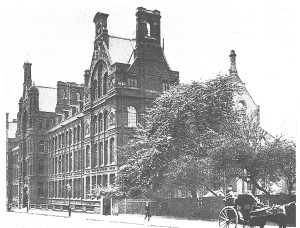The Darwinian Paradox?
The Importance of Workplaced Mathematics – Can the problems be resolved?
How Effective are Current Labour Market Techniques?
Gold Standard?
|
GCE ‘A’ levels curriculum |
Other similar European curriculum (amalgam of the various countries approaches) |
|
Small number of subjects typically four or less studied in depth |
More subjects typically five or more studied in less depth |
|
Free choice of subjects by students |
Less student choice constrained by compulsory core subjects |
|
No criteria for an overall curriculum |
Overall criteria given what constituents a curriculum |
|
Emphasis on end of course external examination |
A variety of assessment approaches e.g. teacher assessment, written exams etc. |
|
No relationship between subjects |
Some subjects require a theory of knowledge element |
|
Schools and colleges responsible for the whole curriculum |
Examination requirements and national regulations determine and define the whole curriculum |
|
No automatic right to enter Higher Education –admission depends on grades |
Automatic right (legal) to enter university in most countries if examination is passed |
|
Reliability of results dependent on the independence of examination boards |
Reliability dependent on state examinations or trust in teachers e.g. Germany and Sweden |
|
Examinations can be a mix of linear and modular syllabuses |
Modular syllabuses non-existent |
Is Mathematics Fit for Employment?
The answer to this long standing question is a resounding no! This is especially certainly true for the mathematics that will be required by most post-16 learners who will progress into employment. The subject is most certainly, fundamental and essential as a body of knowledge but it is the way it is taught and learnt that precipitates the problems. This is particularly important in its application in the workplace and the ability of people to use basic mathematical concepts in everyday life. The level of understanding and ability of the majority of people to apply mathematical and numerical concepts is woefully inadequate in England to cope with the future challenges whether in employment or life in the increasingly scientific and technological world. This sad state is not new one only has to review the innumerable reports, commissions, working parties, focus groups and supposed think traps over the decades. Many of these have presented excellent surveys of the situation but with little effect or impact either in the short and long term. Think tanks indeed! What is needed is DO tanks in the long term! This country is world class in creating bodies to address important issues but these are seldom capable of developing effective and sustained strategies and tactics that bring about solutions to this incredibly important problem.
- Cultural factors
- The existing qualifications frameworks for mathematics and numeracy are flawed and require root and branch reform NOT fudge and mudge/tinkering approaches
- The way mathematics and numeracy programmes are taught and learnt and this coupled with poor teaching produced a damaging cocktail
- The environment in which teaching and learning takes place – this is particularly relevant for technical and vocational education and training – the context is absolutely critical for successful and sustained learning
- The obsession with assessment and testing regimes e.g. teaching to the test syndrome – this results in distortion of content and learning and leads to a lack of understanding of the subjects
- Issues associated with whether or not learning mathematics is perceived as either a pleasurable or painful experience by many learners. (the Cockcroft Report (1982) highlighted this factor)
- The general perception of mathematics, particularly by peers, parents and society in general towards the subject
- The lack of perceived obviousness or immediacy so that people do not turn to mathematics as a first resort to solve everyday problems or to understand the world.
- People often claim to survive and earn a living without having to resort to mathematics
- The increased use of computers, calculators and ICT multimedia with little thought of how these techniques and technologies are managed to develop critical capability. Badly managed teaching and learning methods using these techniques creates a passivity or acceptance in the way people want to or indeed expect to learn. A number of commentators have suggested that the obsession of retrieving information from the internet without the critical second stage of reflection, analysis and verification will eventually bring about an outsourcing of the memory to the internet. A thought – could these technologies actually erode the crucial element of curiosity so essential in the learning and understanding of these subjects?
- Many textbooks are still narrow or mechanical in format and content. Teachers and learners must have access to a wide range of learning materials which are fit for purpose for the learner’s ability and future needs whether for further, higher education and ultimate employment. It is essential that the learning resources are managed effectively by the teachers and this requires appropriate initial and CPD programmes
- A root and branch review is urgently required of mathematics and numeracy that is truly fundamental and recognises the differences that are required in content, emphasis, relevance and ultimate use of the subject by the whole spectrum of learners.
- Many of the problems start at primary school and the reviews must once and for all identify meaningful actions that build a strong foundation for the subject for progression on to the secondary stage of education. A good start has been made with the Rose and Williams report but much, more needs to be done.
- GCSEs and ‘A’ levels are a mess and urgently need a significant over haul -they are most certainly not fit for purpose for the majority of learners.
- Pre-16 learners who intend to undertake apprenticeships or enter college to study technical and commercial programmes must have opportunities and access to more relevant and appropriate work related experiences. Previous attempts such as application of number, functional mathematics have had a limited impact and a radical rethink is urgently required. Attractive and appropriate learning environments must be created in order to facilitate more and or more effective partnerships with local colleges and employers established.
- Post- 16 education and training also requires an urgent review particularly if the school leaving age is raised – the situation will become even more fractured with leaner’s if they have to do more of the same! A comprehensive new set of qualifications are urgently required that are fit for purpose for all the learners.
- Existing technical and vocational programmes must be made more flexible and teachers given more freedom to innovate work based education and training methods. Colleges must be resourced more adequately. The creation of more realistic working environments (RWEs) is essential to establish the correct context for teaching and learning. In addition enhancing links with employers by increasing work placements/sandwich programmes for learners with the relevant employers in order to show how mathematics and numerical concepts are used in the work place.
- The major technical and vocational awarding bodies should as a matter of urgency carry out a fundamental review and audit of their mathematical content of all its programmes to see if they match the requirements of the occupational sectors that the programmes are aimed at.
- The major technical and vocational awarding bodies should establish stronger working links with mathematics organisations and bodies and establish more effective lobbying strategies to government, politicians and civil servants.
The Importance of Context
Finsbury Technical College (1883-1924) and the Central Institution

Sir Philip Magnus (1842-1933)
 Born in London Philip Magnus studied at University College, London graduating in the Arts in 1863 and the University of London graduating in science in 1864. After graduating he continued his theological studies between 1865 and 1866 in Berlin. On returning to London he became a minister at the Berkeley Street Synagogue but gradually became more involved in teaching, lecturing and examining. Philip Magnus in addition to his private teaching he was professor of the Catholic University and wrote a text book entitled “Lessons in Elementary Mechanics” that became a standard work for many years. He increasingly questioned the existing practices and systems of education and was perceived as a radical.
Born in London Philip Magnus studied at University College, London graduating in the Arts in 1863 and the University of London graduating in science in 1864. After graduating he continued his theological studies between 1865 and 1866 in Berlin. On returning to London he became a minister at the Berkeley Street Synagogue but gradually became more involved in teaching, lecturing and examining. Philip Magnus in addition to his private teaching he was professor of the Catholic University and wrote a text book entitled “Lessons in Elementary Mechanics” that became a standard work for many years. He increasingly questioned the existing practices and systems of education and was perceived as a radical.



Recent Comments